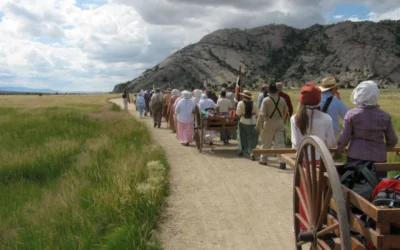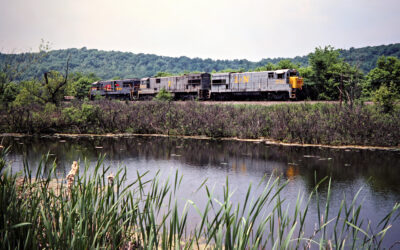One of the First Forts in Kentucky
Our ancestors often leave multiple mysteries when they pass. As family researchers, part of the fun is unraveling these mysteries. Al Horn has been working on the mystery surrounding one of his great-grandfathers who was an early settler at Fort Boonesborough. In this post, Horn presents the evidence he collected along with the questions he has. Maybe you know the answer.
Aaron Horn Sr. and family moved west to Fort Boonesborough in the spring of 1778. I am using a transcript from a Madison Circuit Court at the courthouse in Richmond, Kentucky, in June 1803 as a primary source for this article.[1]
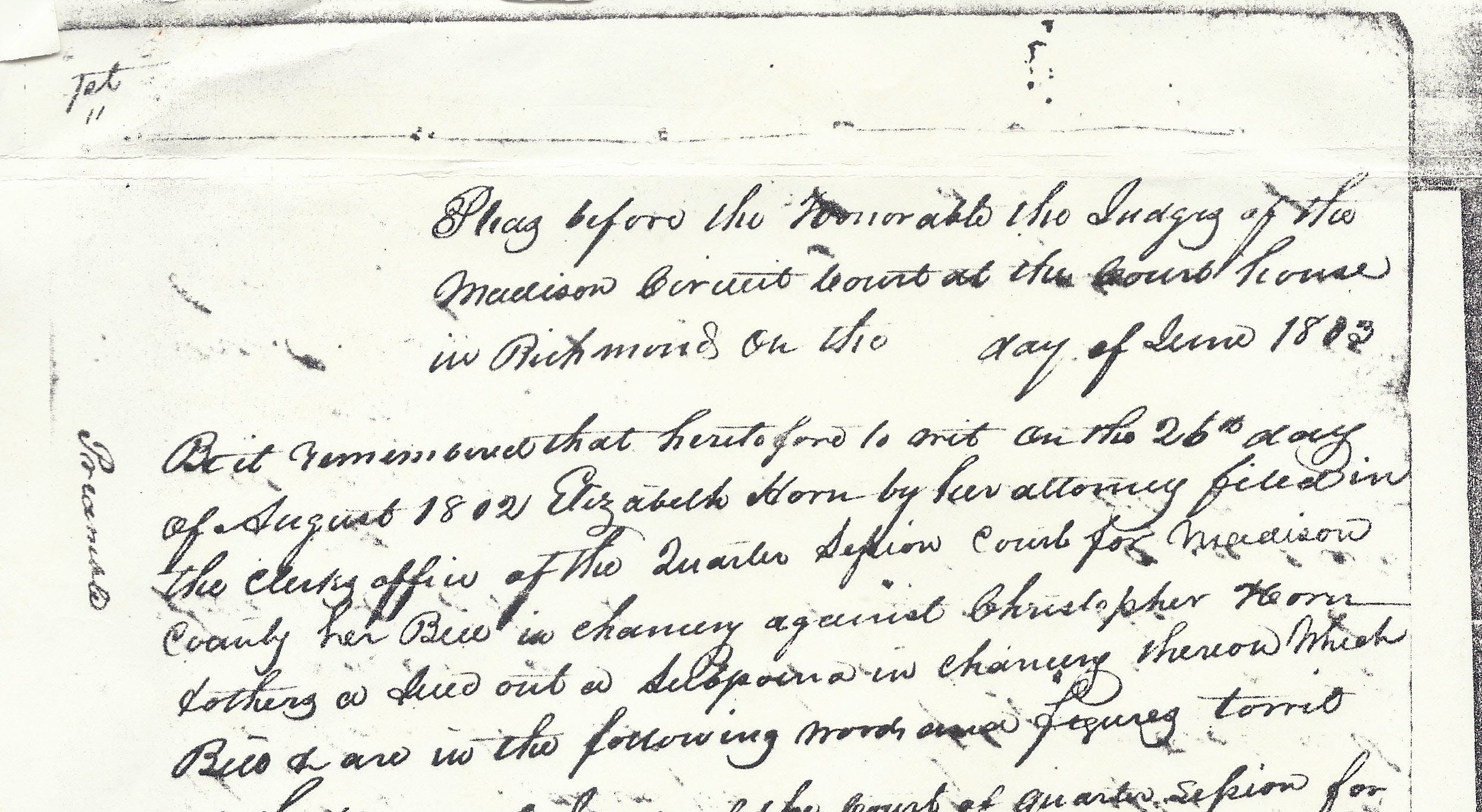
Screen clip of Original Papers from the Madison Circuit Court Richmond, Virginia, in June 1803. Source: Author’s Collection
In this source, the trial is between Aaron’s widow Elizabeth and her eldest son, Christopher Horn, in a land dispute. A court testimony states that Christopher Horn moved to the area years later and would not have been at the fort for the battle in the fall of 1778. Three more sons either testify or are a part of this court record, Mathias, Aron, and William. I believe Aron is misspelled and is Aaron Horn Jr.; Aaron Horn Sr. is also spelled Aron in the court document. Spelling issues were not unusual in early American history.
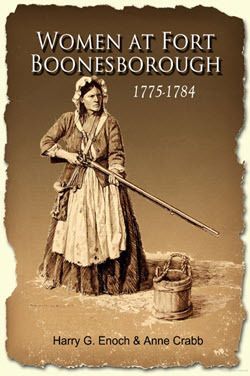
Source: Google Books
The Horn women are covered in the Women At Fort Boonesborough,1775-1784 book, and including the parents and children, indicated a family of eight: the parents, four sons and two daughters.[2] Some sources indicate two more, Jerimiah and another daughter, Elizabeth. I reference the official court record here, however a count of family members is not my purpose, safe to say a big Horn family moved to the fort.
The widow Elizabeth testified in Madison Court in 1803 that “her husband departed this life very shortly after arriving”.[3] People testified that the Horns arrived in the spring of 1778 and Aron Sr. died the following fall, either the last of September or first of October. Testimonials included sons William and Mathew Horn.[4] It is worth noting that Aaron Jr. didn’t testify in 1803, perhaps he didn’t want to participate. Elizabeth Horn is mentioned as a widow at the fort in the Enoch & Crabb book.[5]
On page 28, in the same short paragraph mentioning Daniel Boone, I have seen references to Aaron Horn Sr.’s accidental death. Presumably, he was chopping cane to help refortify the fort after the Great Siege for several days. According to Enoch & Crabb, “The victory proved to be a critical turning point of the Revolutionary War in the West. Had Boonesborough fallen, it is likely all the Kentucky settlements would have been abandoned”.[6]
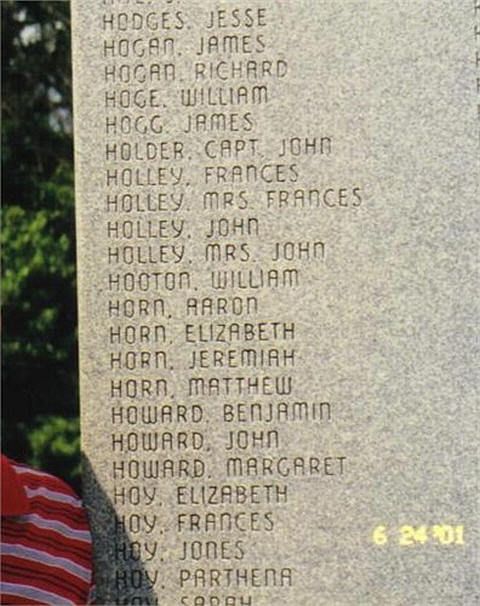
Source: Author’s Collection
There is a monument at the Fort Boonesborough historical site with the following inscription:
“Dedicated by Their Descendants to the Sacred Memory of the Brave Pioneers who Entered the Wilderness of what Later became Kentucky and Formed the Settlement known as Boonesborough, First Fortified Settlement in Kentucky. We Honor These, Among the First Families of Kentucky.”
This monument includes, in order, Aaron, Elizabeth, Jeremiah, and Matthew Horn.
For the First Mystery: Which Aaron Horn is Listed?
There is only one Aaron Horn on the monument and two sons, including Jeremiah. Aaron Horn Sr., was the head of the family, and several sons were in the Fort. My belief is that it is Aaron Horn Sr. on the monument. Many family researchers insist it is Aaron Horn Jr. I received the court record copies from one of these family researchers and questioned that position. How could a monument dedication to brave pioneers not include Aaron Horn Sr. who also died at the fort following the Great Siege? Surely, it must be Aaron Horn Sr. listed above Elizabeth Horn.
If somehow Aaron Horn Sr. was overlooked or intentionally left off, why? If it is indeed Aaron Horn Jr., why would he be listed above his mother and not lower on the monument with two other brothers?
On the other hand, why wouldn’t Aaron Jr. be listed on the monument as well? Christopher wasn’t at the Fort in 1778 and is not on the monument, which makes sense given court testimony from 1803. William Horn was also at the fort and not on the monument. Jeremiah Horn is on the monument, but not mentioned in the 1803 court case. I assume he must have been at the Fort unless the monument is in error. There are issues presented by the names on or off the monument. Is this just in error? Or could it be an omission?
The Second Mystery: How did Aaron Horn, Sr., Die?
There is no doubt about his death based upon the 1803 court record.[7] There are testimonies from family and friends that were aware Aaron Horn had died in the fall of 1778. No testimonies mentioned how he died. Family legend has it that Aaron Horn Sr. cut his hand while chopping cane, got infected and proved fatal.[8]
Accidents happen, but that is certainly a strange cause of death. Especially for an experienced farmer that helped to clear a trail to Boonesborough. It was a rough wilderness area, still they should have been able to stop the bleeding and cover up the wound. Cleanliness could have been an issue given the environment. There were other deaths during the battle, no doubt including bleeding.
There is no military record for Aaron Horn Sr. as there is for at least three sons. There is also no proof he was wounded in defense of the Fort. I would assume he and other non-enlisted men and women were helping to defend the fort, or face death from the attackers. There is no burial site information or record of death that family historians have been able to find. I have had communications with people that were unable to locate a grave at or near the original fort site.
Considering the Mysteries
To summarize, a strange death with no record and no burial site. This seems very odd, even when considering the wilderness area before Kentucky became a state. I am not suggesting foul play, but is it possible that Aaron Horn Sr. was captured and/or killed by the Native Americans allied with the British?
Even Daniel Boone was captured by Native Americans according to Enoch & Crabb.[9] He eventually escaped and returned to Boonesborough. Perhaps Aaron Horn Sr. was not so fortunate, and the family chose not to acknowledge his capture?
Purely speculation on my part and the mystery remains.
Editor’s Notes
Update: Family members contacted Al and were able to provide more details about this man. Thanks to all who did that.
Vicki Whitaker, Registrar from Society of Boonesborough, suggested this additional text for researchers: “Anne Crabb’s book, “And The Battle Began Like Claps of Thunder,” is a very accurate account of those living at Boonesborough during the Siege of 1778.”


